NCERT Solutions Class 6 Maths Chapter - 5: Understanding Elementary ShapesExercise 5.11. What is the disadvantage in comparing line segments by mere observation? Answer: The comparison of line segments by observation does not give the exact idea of its length. The chances of error due to improper viewing are greater. 2. Why is it better to use a divider than a ruler, while measuring the length of a line segment? Answer: It is better to use a divider than a ruler while measuring the length of a line segment because it provides the accurate measurements. A divider has basic measurements that easily helps us to find the length of any given line segment. 3. Draw any line segment, say AB. Take any point C lying in between A and B. Measure the lengths of AB, BC and AC. Is AB = AC + CB? Note: If A, B, C are any three points on a line such that AC + CB = AB, then we can be sure that C lies between A and B.Diagram: 
Answer: AC = 2 cm BC = 2.3 cm AB = 4.3 cm Yes, AB = AC + CB AB = 2 cm + 2.3 cm AB = 4.3 cm It is because point C lies between the line segments AB. 4. If A, B, C are three points on a line such that AB = 5 cm, BC = 3 cm and AC = 8 cm, which one of them lies between the other two? Answer: AC is a bigger line segment. Thus, AC = AB + BC It shows that point B lies between point A and C. AC = AB + BC AC = 5 cm + 3 cm AC = 8 cm 5. Verify, whether D is the midpoint of AG. 
Answer: Yes, D is the mid-point of the line segment AG. There are total seven points in the above line segment. Mid-point = 7 + 1/2 = 4 Thus, 4th point (D) is the mid-point of the line segment AG. 6. If B is the midpoint of AC and C is the midpoint of BD, where A, B, C, D lie on a straight line, say why AB = CD? Answer: Let's assume the above line segment as: 
B is the midpoint of AC. A mid-point equally divides a line into two equal parts. Thus, AB = BC C is the mid-point of BD Thus, BC = CD Hence, we can say that AB = BC = CD AB = CD 7. Draw five triangles and measure their sides. Check in each case, if the sum of the lengths of any two sides is always less than the third side. Answer: The five triangles are: 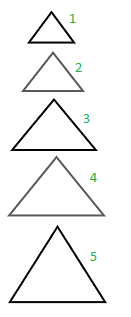
Sum of length of two sides of the first triangle: 1 cm + 1 cm = 2cm Length of the third side = 1 cm Sum of length of two sides of the second triangle: 2 cm + 2 cm = 4 cm Length of the third side = 2 cm Sum of length of two sides of the third triangle: 3 cm + 3 cm = 6cm Length of the third side = 3 cm Sum of length of two sides of the fourth triangle: 4 cm + 4 cm = 8cm Length of the third side = 4 cm Sum of length of two sides of the fifth triangle: 5 cm + 5 cm = 10 cm Length of the third side = 5 cm Thus, sum of length of two sides of a triangle is never less than the length of its third side. Exercise 5.21. What fraction of a clockwise revolution does the hour hand of a clock turn through, when it goes from? (a) 3 to 9 Answer: 1/2 Explanation: 3 to 9 = 6 hours There are total 12 hours in a watch. Fraction of clockwise revolution = Number of hours a clock turn/Total number of hours = 6/12 = 1/2 (b) 4 to 7 Answer: 1/4 Explanation: 4 to 7 = 3 hours There are total 12 hours in a watch. Fraction of clockwise revolution = Number of hours a clock turn/Total number of hours = 3/12 = 1/4 (c) 7 to 10 Answer: 1/4 Explanation: 7 to 10 = 3 hours There are total 12 hours in a watch. Fraction of clockwise revolution = Number of hours a clock turn/Total number of hours = 3/12 = 1/4 (d) 12 to 9 Answer: 3/4 Explanation: 12 to 9 = 9 hours There are total 12 hours in a watch. Fraction of clockwise revolution = Number of hours a clock turn/Total number of hours = 9/12 = 3/4 (e) 1 to 10 Answer: 3/4 Explanation: 1 to 10 = 9 hours There are total 12 hours in a watch. Fraction of clockwise revolution = Number of hours a clock turn/Total number of hours = 9/12 = 3/4 (f) 6 to 3 Answer: 3/4 Explanation: 6 to 3 = 9 hours There are total 12 hours in a watch. Fraction of clockwise revolution = Number of hours a clock turn/Total number of hours = 9/12 = 3/4 2. Where will the hand of a clock stop if it (a) Starts at 12 and makes ½ of a revolution, clockwise? Answer: 6 Explanation: 1 revolution = 12 hours ½ of a revolution = 12/2 = 6 hours Thus, starting at 12 and making a ½ of a revolution clockwise is equal to 6. (b) Starts at 2 and makes ½ of a revolution, clockwise? Answer: 8 Explanation: 1 revolution = 12 hours ½ of a revolution = 12/2 = 6 hours Thus, starting at 2 and making a ½ of a revolution clockwise is equal to 8. (c) Starts at 5 and makes ¼ of a revolution, clockwise? Answer: 8 Explanation: 1 revolution = 12 hours ¼ of a revolution = 12/4 = 3 hours Thus, starting at 5 and making a ¼ of a revolution clockwise is equal to 8. (d) Starts at 5 and makes ¾ of a revolution, clockwise? Answer: 2 Explanation: 1 revolution = 12 hours ¾ of a revolution = (12 � 3)/4 = 9 hours Thus, starting at 5 and making a ¾ of a revolution clockwise is equal to 2. 3. Which direction will you face if you start facing? 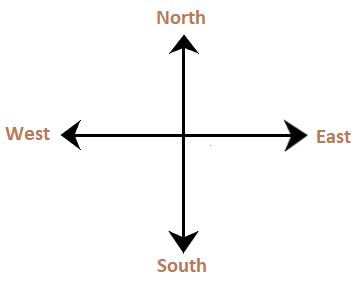
1 revolution is equal to full turn of 360 degrees. (a) East and make ½ of a revolution clockwise? Answer: West Explanation: 1 revolution = 360 degrees or 12 hours ½ revolution = 180 degrees or 6 hours Turning east and making ½ of a revolution clockwise, result in the west direction. (b) East and make 1½ of a revolution clockwise? Answer: West Explanation: 1½ = 3/2 3/2 x 12 hours = 18 hours Or 3/2 x 360 = 540 degrees Thus, the clock will make one full turn + one half turn. = East to East and again from East to West (c) West and make ¾ of a revolution anti-clockwise? Answer: North Explanation: ¾ of a revolution = 9 hours Or 270 degrees 9 hours in the anti-clockwise direction will turn it to the North direction. Similarly, the same 9 hours in the clockwise direction will turn it to the South direction. (d) South and make one full revolution? (Should we specify clockwise or anti-clockwise for this last question? Why not? ) Answer: South Explanation: 1 full revolution results in the same direction. No, we are not required to specify clockwise or anti-clockwise for this last question because the clock will turn at the South direction only, either clockwise or anti-clockwise. 4. What part of a revolution have you turned through if you stand facing? 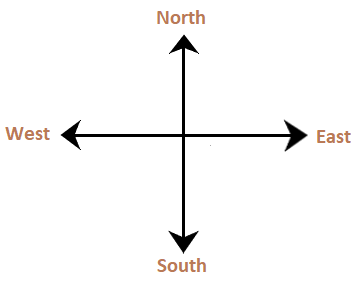
(a) East and turn clockwise to face north? Answer: 3/4 Explanation: Turning to the north in the clockwise direction from east requires covering South, West, and North. Thus, three directions out of the four directions are covered while turning. (b) South and turn clockwise to face east? Answer: 3/4 Explanation: Turning to the east in the clockwise direction from south requires covering West, North, and East. Thus, three directions out of the four directions are covered while turning. (c) West and turn clockwise to face east? Answer: 1/2 Explanation: Turning to the east in the clockwise direction from west requires covering North, and East. Thus, two directions out of the four directions are covered while turning. 5. Find the number of right angles turned through by the hour hand of a clock when it goes from 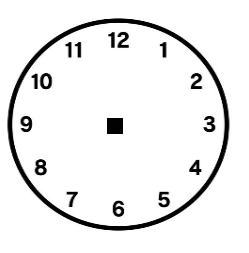
(a) 3 to 6 Answer: 1 Explanation: 3 to 6 difference = Three hours 3 hours covered by a hour hand = 1 right angle Only one right angle is covered by the hour hand of a clock when it goes from 3 to 6. (b) 2 to 8 Answer: 2 Explanation: 2 to 8 difference = 6 hours 3 hours covered by a hour hand = 1 right angle 6 hours = 2 right angles Two right angles are covered by the hour hand of a clock when it goes from 2 to 8. (c) 5 to 11 Answer: 2 Explanation: 5 to 11 difference = 6 hours 3 hours covered by a hour hand = 1 right angle 6 hours = 2 right angles Two right angles are covered by the hour hand of a clock when it goes from 5 to 11. (d) 10 to 1 Answer: 1 Explanation: 10 to 1 difference = 3 hours 3 hours covered by a hour hand = 1 right angle Only one right angle is covered by the hour hand of a clock when it goes from 10 to 1. (e) 12 to 9 Answer: 3 Explanation: 12 to 9 difference = 9 hours 3 hours covered by a hour hand = 1 right angle 9 hours = 3 right angles Three right angles are covered by the hour hand of a clock when it goes from 12 to 9. (f) 12 to 6 Answer: 2 Explanation: 12 to 6 difference = 6 hours 3 hours covered by a hour hand = 1 right angle 6 hours = 2 right angles Two right angles are covered by the hour hand of a clock when it goes from 12 to 6. 6. How many right angles do you make if you start facing? (a) South and turn clockwise to west? Answer: 1 Explanation: Only one turn from south to west is required in the clockwise direction. One turn = 1 right angle (b) North and turn anti-clockwise to east? Answer: 3 Explanation: Three turns are required in anti-clockwise from North direction to the east. One turn = 1 right angle Three turns = Three right angles (c) West and turn to west? Answer: 4 Explanation: Turning to a same direction always requires one revolution, i.e. 4 right angles. (d) South and turn to north? Answer: 2 Explanation: Two turns are required in from South direction to the North either in the clockwise direction or anti-clockwise. 7. Where will the hour hand of a clock stop if it starts? (a) From 6 and turns through 1 right angle? Answer: 9 Explanation: 1 right angle = 3 hours 6 + 3 = 9 Thus, the hour hand of a clock stops at 9 if it starts from 6 and turns through 1 right angle. (b) From 8 and turns through 2 right angles? Answer: 2 Explanation: 1 right angle = 3 hours 2 right angles = 6 hours 8 + 6 = 2 (in the clock) Thus, the hour hand of a clock stops at 2 if it starts from 8 and turns through 2 right angles. (c) From 10 and turns through 3 right angles? Answer: 7 Explanation: 1 right angle = 3 hours 3 right angles = 9 hours 10 + 9 = 7 (in the clock) Thus, the hour hand of a clock stops at 7 if it starts from 10 and turns through 3 right angles. (d) From 7 and turns through 2 straight angles? Answer: 7 Explanation: 1 straight angle = 6 hours There are 2 straight angles in a clock. We can also say that 1 straight angle is equal to 180 degrees, where 1 revolution is of 360 degrees. 2 straight angles = 12 hours Thus, the hour hand of a clock stops at the same time 7 if it starts from 7 and turns through 2 straight angles. Exercise 5.31. Match the following: (i) Straight angle (c) Half of a revolution (ii) Right angle (d) One-fourth of a revolution (iii) Acute angle (a) less than one-fourth of a revolution (iv) Obtuse angle (e) between 1/4 and 1/2 of a revolution (v) Reflex angle (b) More than half a revolution Explanation: One revolution = 360 degrees Half revolution = 180 degrees 1/4th of a revolution = 90 degrees Straight angle is the angle formed by a straight line, which is equal to 180 degrees. Hence, straight angle is equal to half of a revolution. Right angle is the angle of 90 degrees. Hence, it has value equal to one-fourth of a revolution. Acute angle is the angle whose value is less than 90 degrees. Hence, acute angle has value less than one-fourth of a revolution. Obtuse angle is the angle whose value is greater than 90 degrees and less than 180 degrees. Hence, obtuse angle has value equal to between 1/4 and 1/2 of a revolution. Reflex angle is the angle whose value is greater than 180 degrees and less than 360 degrees. Hence, reflex angle has value more than half a revolution. 2. Classify each one of the following angles as right, straight, acute, obtuse or reflex: 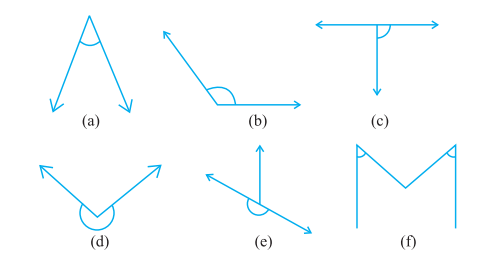
(a) Answer: Acute angle Explanation: An acute angle is the angle less than 90 degrees. (b) Answer: Obtuse angle Explanation: The angle greater than 90 degrees but less than 180 degrees is an obtuse angle. (c) Answer: Right angle Explanation: Right angle is the angle of 90 degrees. (d) Answer: Reflex angle Explanation: The angle greater than 180 degrees but less than 360 degrees is termed as an reflex angle. (e) Answer: Straight angle Explanation: The angle formed on a straight line is termed as the straight angle, which is equal to 180 degrees. (f) Answer: Acute angle Explanation: An acute angle is the angle less than 90 degrees. Both the angles are the acute angles. Exercise 5.41. What is the measure of? (i) A right angle? Answer: 90° Explanation: A right angle is equal to 90 degrees. (ii) A straight angle? Answer: 180° Explanation: A straight angle is formed on a straight line, which is equal to 180 degrees. 2. Say True or False: (a) The measure of an acute angle < 90°. Answer: True Explanation: The value of an acute angle is always less than 90 degrees. (b) The measure of an obtuse angle < 90°. Answer: False Explanation: The value of an obtuse angles lies between 90 degrees and 180 degrees. (c) The measure of a reflex angle > 180°. Answer: True Explanation: The value of reflex angle is greater than 180 degrees. (d) The measure of one complete revolution = 360°. Answer: True Explanation: One complete revolution is equal to 360 degrees. (e) If m∠ A = 53° and m∠ B = 35°, then m∠ A > m∠ B. Answer: True Explanation: The value of angle A is greater than the value of angle B. 3. Write down the measures of (a) Some acute angles. Answer: Acute angles are the angles whose value is less than 90 degrees. Examples: 55°, 28°, 78°, 46° (b) Some obtuse angles. Answer: Obtuse angles are the angles whose value is greater than 90 degrees and less than 180 degrees. Examples: 95°, 108°, 172°, 140° (Give at least two examples of each). 4. Measure the angles given below using the Protractor and write down the measure. 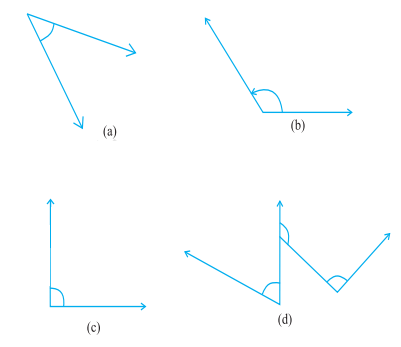
5. Which angle has a large measure? First estimate and then measure 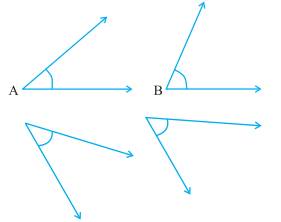
Measure of Angle A = 40° Measure of Angle B = 68° 6. from these two angles which has larger measure? Estimate and then confirm by measuring them. Angle B has the larger measure. 7. Fill in the blanks with acute, obtuse, right or straight: (a) An angle whose measure is less than that of a right angle is acute. Explanation: The value of an acute angle is less than 90 degrees. 1 right angle = 90 degrees (b) An angle whose measure is greater than that of a right angle is obtuse. Explanation: The value of an obtuse angle is greater than 90 degrees. 1 right angle = 90 degrees (c) An angle whose measure is the sum of the measures of two right angles is straight. Explanation: 1 right angle = 90 degrees 2 right angles = 180 degrees A straight angle is the angle formed on a straight line, whose value is equal to 180 degrees. (d) When the sum of the measures of two angles is that of a right angle, then each one of them is acute. Explanation: The value of an acute angle is less than 90 degrees. 1 right angle = 90 degrees A + B = 90 Thus, both two angles A and B have value less than 90 degrees. For example, 35 + 55 = 90 (e) When the sum of the measures of two angles is that of a straight angle and if one of them is acute then the other should be obtuse. Explanation: The value of an acute angle is less than 90 degrees. The value of an obtuse angle is greater than 90 degrees. A + B = 180 Straight angle = 180 If A is acute, then B should be obtuse to obtain the sum of 180. For example, A = 75 B = 180 - 75 B = 105 degrees 8. Find the measure of the angle shown in each figure. (First estimate with your eyes and then find the actual measure with a protractor). Answer: The above shown angles are 40°, 130°, 65° and 135°. 9. Find the angle measure between the hands of the clock in each figure: 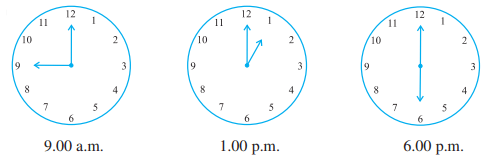
There are 12 hands of a clock. 12 hands = 360 degree or 1 revolution 1 hand = 360/12 = 30 degrees Thus, each hand of a clock makes an angle of 30 degrees.
10. Investigate in the given figure, the angle measures 30°. Look at the same figure through a magnifying glass. Does the angle become larger? Does the size of the angle change? No. The angle does not become large while watching through a magnifying class. It has the same value. 11. Measure and classify each angle 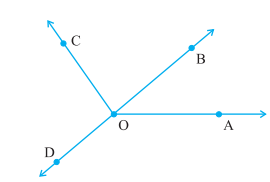
The angle with value less than 90 degrees is classified as an acute angle. The angle with value greater than 90 degrees is classified as an obtuse angle. The angle with value equal to 180 degrees is classified as a straight angle. Exercise 5.51. Which of the following are models for perpendicular lines? (a) The adjacent edges of a table top. Answer: Yes The adjacent edges of a table top are perpendicular to each other, i.e., at 90 degrees. (b) The lines of a railway track. Answer: No The lines of a railway track are parallel to each other, not perpendicular. (c) The line segments forming the letter 'L'. Answer: Yes The line segments forming the letter 'L' are perpendicular to each other, i.e., at 90 degrees. (d) The letter V. Answer: No The letter V does not form an angle of 90 degrees. Hence, they are not perpendicular. 2. Let PQ be the perpendicular to the line segment XY. Let PQ and XY intersect in the point A. What is the measure of ∠PAY? Answer: 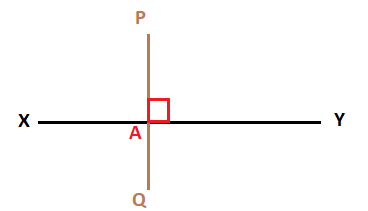
The measure of ∠PAY is equal to 90 degrees. Explanation: The line PQ is perpendicular to the line segment XY. A perpendicular line always forms a 90 degree angle with the intersecting line segment. Hence, the value of all the angles∠PAY, ∠PAX, ∠XAQ, and ∠QAY is equal to 90 degrees. 3. There are two set-squares in your box. What are the measures of the angles that are formed at their corners? Do they have any angle measure that is common? Answer: One is a 30°, - 60°, - 90° set square and the other is a 45°, - 45°, - 90° set square. Yes. Both set squares have one angle in common, i.e., 90 degrees. 4. Study the diagram. The line l is perpendicular to line m 
(a) Is CE = EG? Answer: Yes The gap between the two lines is equal, i.e. 2 units. Hence, CE = EG. (b) Does PE bisect CG? Answer: Yes Bisect means to intersect a line. PE intersects the line CG. Hence, the answer is yes. (c) Identify any two line segments for which PE is the perpendicular bisector. Answer: BH, DF There are multiple line segments for which PE is the perpendicular bisector.
We can write any of the two line segments in the answer. (d) Are these true? (i) AC > FG Answer: True Difference of AC = 3 - 1 = 2 units Difference of FG = 7 - 6 = 1 unit Hence, AC > FG (ii) CD = GH Answer: True Difference of CD = 4 - 3 = 1 unit Difference of GH = 8 - 7 = 1 unit Hence, CD = GH (iii) BC < EH. Answer: True Difference of BC = 3 - 2 = 1 unit Difference of EH = 8 -5 = 3 units Hence, BC < EH Thus, all of the above answers are true. Exercise 5.61. Name the types of following triangles: (a) Triangle with lengths of sides 7 cm, 8 cm and 9 cm. Answer: Scalene triangle A triangle with all the three sides of unequal length is called a scalene triangle. (b) ∆ABC with AB = 8.7 cm, AC = 7 cm and BC = 6 cm. Answer: Scalene triangle A triangle with all the three sides of unequal length is called a scalene triangle. (c) ∆PQR such that PQ = QR = PR = 5 cm. Answer: Equilateral triangle A triangle with all the three sides of equal length is called an equilateral triangle. (d) ∆DEF with m∠D = 90° Answer: Right angle triangle A triangle with any one angle as a right angle is called a right angle triangle. (e) ∆XYZ with m∠ Y = 90° and XY = YZ. Answer: Isosceles right angled A triangle with two equal sides and one right angle is called an isosceles right angled triangle. (f) ∆LMN with m∠ L = 30°, m∠ M = 70° and m∠ N = 80°. Answer: Acute angled triangle A triangle with angles less than 90 degrees is called an acute angle triangle. 2. Match the following: Measures of Triangle Type of Triangle (i) 3 sides of equal length (e) Equilateral (ii) 2 sides of equal length (g) Isosceles (iii) All sides are of different length (a) Scalene (iv) 3 acute angles (f) Acute angled (v) 1 right angle (d) Right angled (vi) 1 obtuse angle (c) Obtuse angled (vii) 1 right angle with two sides of equal length (b) Isosceles right angled 3. Name each of the following triangles in two different ways: Answer: 4. Try to construct triangles using match sticks. Some are shown here. Can you make a triangle with? (a) 3 matchsticks? 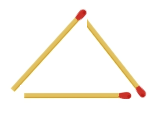
It is an equilateral triangle because all the three matchsticks are of equal length. (b) 4 matchsticks? 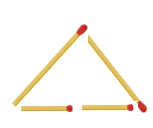
It is an isosceles triangle because the two sides of the triangle are equal. (c) 5 matchsticks? 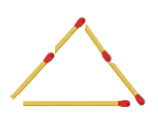
It is an isosceles triangle because the two sides of the triangle are equal. (d) 6 matchsticks? 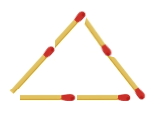
It is an equilateral triangle because each side is made of two matchsticks of equal size. (Remember you have to use all the available matchsticks in each case) Name the type of triangle in each case. If you cannot make a triangle, think of reasons for it. Exercise 5.71. Say True or False: (a) Each angle of a rectangle is a right angle. Answer: True Explanation: A rectangle has equal opposite sides equal and four right angles with each angle of 90 degrees. (b) The opposite sides of a rectangle are equal in length. Answer: True Explanation: A rectangle has equal opposite sides equal and four right angles with each angle of 90 degrees. (c) The diagonals of a square are perpendicular to one another. Answer: True Explanation: The diagonals of a square are equal and perpendicular to one another. (d) All the sides of a rhombus are of equal length. Answer: True Explanation: Rhombus is a type of square with all equal sides. (e) All the sides of a parallelogram are of equal length. Answer: False Explanation: A parallelogram may have sides of unequal length. (f) The opposite sides of a trapezium are parallel. Answer: False Explanation: Only one pair of opposite sides of a trapezium is parallel. 2. Give reasons for the following: (a) A square can be thought of as a special rectangle. Answer: A square can be thought of as a special rectangle if all its sides are equal. (b) A rectangle can be thought of as a special parallelogram. Answer: A rectangle can be thought of as a special parallelogram with equal opposite sides and each angle of 90 degrees. (c) A square can be thought of as a special rhombus. Answer: A square can be thought of as a special rhombus if it's each is of 90 degrees. (d) Squares, rectangles, parallelograms are all quadrilaterals. Answer: Squares, rectangles, parallelograms are all quadrilaterals because all are the polygons made of four line segments. (e) Square is also a parallelogram. Answer: Square is also a parallelogram with equal opposite sides. 3. A figure is said to be regular if its sides are equal in length and angles are equal in measure. Can you identify the regular quadrilateral? Answer: Square A square is a regular quadrilateral with equal sides and angles. Exercise 5.8Examine whether the following are polygons. If anyone among them is not, say why? 
Answer:
2. Name each polygon. Make two more examples of each of these. Answer:
A four sided polygon is known as a Quadrilateral. A three sided polygon is known as a triangle. A five sided polygon is known as a pentagon. An eight sided polygon is known as an octagon. Examples: Quadrilateral 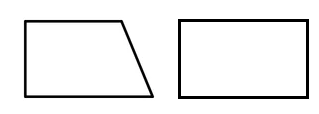
Triangle 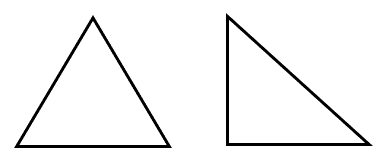
Pentagon 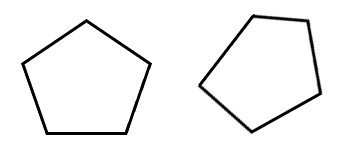
Octagon 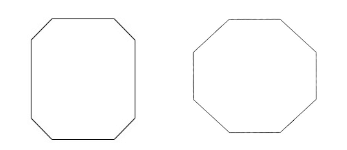
3. Draw a rough sketch of a regular hexagon. Connecting any three of its vertices, draw a triangle. Identify the type of the triangle you have drawn. Answer: 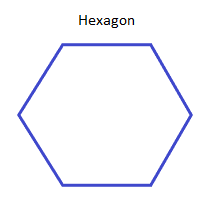
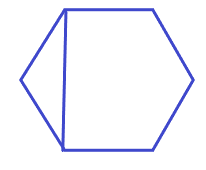
All the sides of a regular hexagon are equal. The type of triangle formed by joining any two points of a hexagon is an isosceles triangle because its two sides are equal. 4. Draw a rough sketch of a regular octagon. (Use squared paper if you wish). Draw a rectangle by joining exactly four of the vertices of the octagon. Answer: 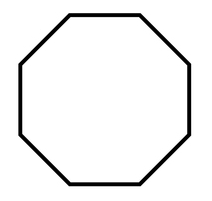
The rectangle formed by joining four of its vertices is: 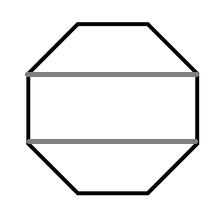
5. A diagonal is a line segment that joins any two vertices of the polygon and is not a side of the polygon. Draw a rough sketch of a pentagon and draw its diagonals. Answer: A pentagon is a five-sided polygon. The diagonals of a pentagon are shown below: 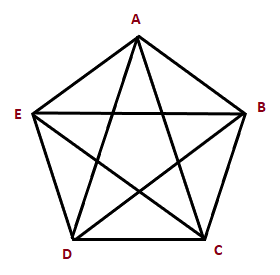
ABCDE is a pentagon and AC, AD, EB, EC, DB are the diagonals of the pentagon. Exercise 5.91. Match the following: (a) Cone Answer: 
Examples: The examples of cone are:
(b) Sphere Answer: 
Examples: The examples of sphere are:
(c) Cylinder Answer: 
Examples: The examples of cylinder are:
(d) Cuboid Answer: 
Examples: The examples of cuboid are:
(e) Pyramid Answer: 
Examples: The examples of pyramid are:
Give two new examples of each shape. 2. What shape is (a) Your instrument box? Answer: The instrument box is in the shape of a cuboid. (b) A brick? Answer: The brick is in the shape of a cuboid. (c) A match box? Answer: The match box is in the shape of a cuboid. (d) A road-roller? Answer: The road-roller is in the shape of a cylinder. (e) A sweet laddu? Answer: A sweet laddu is in the shape of a sphere.
Next TopicClass 6 Maths Chapter 6
|
 For Videos Join Our Youtube Channel: Join Now
For Videos Join Our Youtube Channel: Join Now
Feedback
- Send your Feedback to [email protected]
Help Others, Please Share









